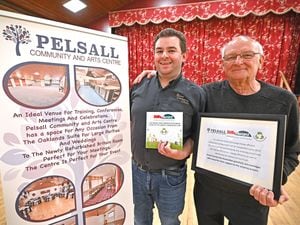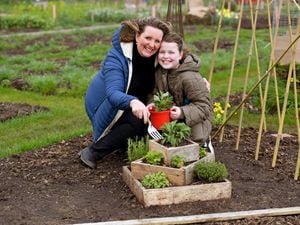Black Country's green belt under siege in the rush for homes
Angry residents say they feel ignored by a consultation into plans to build thousands of homes on green belt sites across the region.
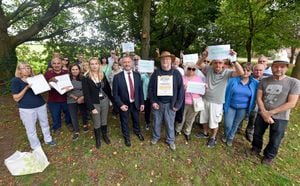
Under the Black Country Plan more than 7,000 houses will go up on green belt land as part of a battle to hit what councils say is an unrealistic target of 76,000 homes by 2039.
But residents today described a consultation process, which has just 19 days to run, as “overly complicated” and a “done deal” and that precious green sites will be lost for good. Tory MPs in the region have spoken out against the plan. And Shadow Communities Secretary Steve Reed says people are not being listened to.
In the heart of the Black Country, just a stone’s throw away from the permanently busy A449, lies a plot of land - one of dozens being earmarked for development - that is beloved by thousands of people in the surrounding community.
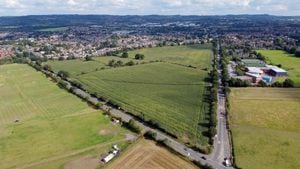
For residents, the site off Holbeache Lane in Wall Heath offers respite in the middle of a built-up area, an oasis of tranquillity to escape to for a few moments for some peace and quiet.
During the pandemic the field became even more vital, serving as a place where people could meet safely outdoors around the multitude of wildlife species that call it home.
But if developers have their way, this prime plot of green belt land will soon be gone, flattened to make way for a new housing estate that by the end of the next decade could contain 330 homes.
“It would be horrendous for the local community if they build on here – particularly when you look at the sheer number of houses they are planning,” said Pam Haden, who lives on nearby Holcroft Road.
“As a green space it is so important for people’s health and wellbeing. Nobody wants to see it go. We hear a lot about how important it is to protect the environment and the green belt is supposed to be sacrosanct, yet they want to build on here.”
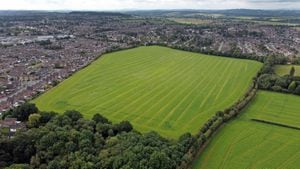
Down the road another green belt plot, The Triangle, is also under threat. It is one of eight sites in and around Wall Health that have been earmarked for up to 1,750 homes.
Residents are determined to fight to protect both sites, and it is not just the potential loss of green space that rankles with them. Tracey Parbery, who lives on Beachcroft Road, said infrastructure – including roads, schools, doctors surgeries and the local hospital – was already struggling to cope.
“This area simply cannot cope with so many extra houses and so many extra people,” she said. “We understand there has to be new houses but building on the green belt is not the answer.”
The situation is currently being mirrored across the Black Country and into Staffordshire and Shropshire, where local plans are being put forward that aim to meet a demand for housing that has started to spiral out of control.
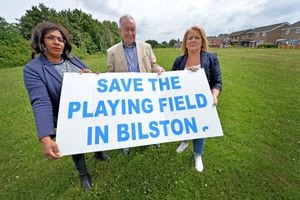
While the majority of the proposed homes are lined up for brownfield sites, planners are looking to free up dozens of green belt plots for development too.
Under the Black Country Plan, which is out for consultation until October 11, dozens of greenbelt sites have been put forward for more than 7,000 homes.
Critics argue that if all of them are signed off for development, the face of the region will change for good, with villages merging to become conurbations and green spaces disappearing for good.
Many residents have already slammed the consultation process, describing it at a meeting last week as “overly complicated” and “absolute crap”, with fears abound that it is little more than a box ticking exercise for housing plans that are already a done deal.
A similar plan is due to be published for South Staffordshire. Steve Cutler, a member of the Wall Heath As One campaign group, said put together the schemes could see the population of Wall Heath and Kingswinford North double by the time developers have finished.
According to council chiefs, housing targets for the region – which are devised by ministers and implemented on a local level – cannot be met with brownfield sites alone.
Unless the targets are reduced, they say, developing on the green belt is inevitable.
Unsurprisingly, the issue has become something of a political football. For councils in the West Midlands – including Conservative-run administrations in Walsall and Dudley – the Government’s housing target of 215,000 new homes by 2031 is simply too high.
Meanwhile Labour has accused the Government of letting down local communities by playing into the hands of developers.
Shadow Communities Secretary Steve Reed MP and Dudley councillor Judy Foster heard the concerns of residents during a visit to the Holbeache Road site.
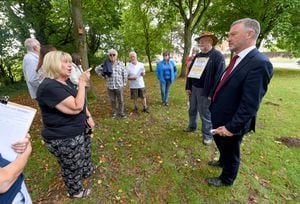
Mr Reed said: “Residents feel they are not being listened to and have not been allowed to take part in the decisions over what happens to their area.
“In a democracy that is fundamentally wrong. If you put too much pressure on local infrastructure then everyone in the community suffers.
“In my view, there should be no building on the green belt if you have alternatives available like bringing empty homes back into use and building on brownfield sites.
“And where councils have given approval for developers to build homes - make those developers build. Do all of that and you may not need to build on the green belt.
“Labour’s approach is that we need a genuine partnership between the council, developers and the local community if we are to get regeneration that is in everyone’s interests.
“At the moment the voice of developers has been strengthened while the voice of communities has been weakened.”
Mike Wood, the Conservative MP for Dudley South, has joined campaigners in fighting the planned schemes in Wall Heath. He said the issue was “much more important than political point scoring” and insisted there was scope for further brownfield development in the borough.
“We can do more without having to build on the green belt, particularly in terms of town centre development,” he said.
“It won’t be easy and it will need a lot of investment. The bottom line is that if we release this green belt now it is gone forever.
“We need to explore every avenue in the weeks remaining in the consultation to ensure that everyone has their say.”
West Midlands Mayor Andy Street has also questioned whether the region’s available brownfield sites have been exhausted. A review he launched into the issue is ongoing.
While the arguments go back and forth, it is questionable whether any of our politicians have a workable solution that truly protects the green belt, although new Housing Secretary Michael Gove is apparently ready to tear up a contentious planning shake-up partly over its potential to drastically reduce the country’s green spaces.
In the West Midlands, most people seem to agree that there is a housing need to meet a growing population, but fears are growing that in the race to expand, the green belt is being viewed as an easy sacrifice.
The debate rumbles on, but residents fear that if these plans go ahead it is they who will ultimately lose out.


